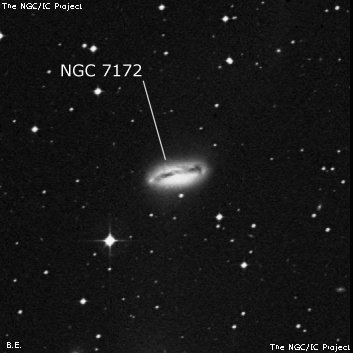
John Herschel discovered NGC 7172 = h3908 on 23 Sep 1834 and logged "pB; R; 40"." His position (measured on 4 sweeps) is accurate. The dark rift was first noted by Knox-Shaw in 1912, based on a photograph taken in 1909-11 with the 30" Reynolds reflector at the Helwan Observatory.
200/250mm - 8" (7/24/82): very faint, fairly small, elongated E-W.
300/350mm - 13.1" (7/27/84): moderately bright, fairly large, elongated, fairly diffuse. Brightest of four in HCG 90. The compact trio consisting of NGC 7173, NGC 7174, NGC 7176 is roughly 7' S.
400/500mm - 18" (10/21/06): moderately bright, fairly large, elongated ~2:1 E-W, ~1.8'x1.0', broad concentration. A mag 10.6 star lies 2.5' SE and two mag 13 stars 1.5' SW and 3' SW are collinear with the galaxy.
18" (9/3/05): moderately bright, fairly large, elongated 5:2 WNW-ESE, 1.4'x0.6', contains a brighter bulging core. A mag 10.5 star lies 2.5' SE. Located ~7' N of the main grouping (NGC 7173, NGC 7174, NGC 7176) in HCG 90) and largest in the group.
600/800mm - 24" (8/23/14): at 375x; moderately bright, fairly large, elongated 5:2 WNW-ESE, ~1.5'x0.6', increases in size with averted. Contains a brighter, elongated core that bulges slightly and the halo has a sharper edge along with south edge. NGC 7173, 7174 and 7176 triplet lies ~7' SSE, the quartet forming HCG 90.
Notes by Steve Gottlieb